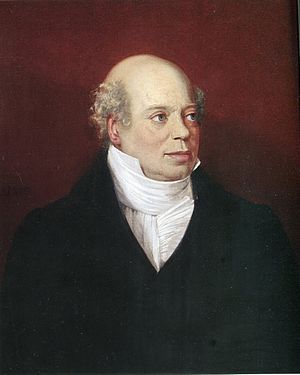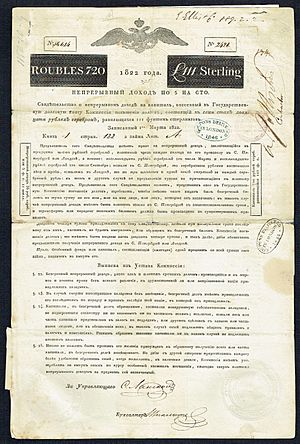Nathan Mayer Rothschild facts for kids
Quick facts for kids
Nathan Mayer Rothschild
|
|
|---|---|
 |
|
| Born | 16 September 1777 Frankfurt, Holy Roman Empire
|
| Died | 28 July 1836 (aged 58) Frankfurt, German Confederation
|
| Known for | Rothschild banking family of England |
| Spouse(s) |
Hannah Barent-Cohen
(m. 1806) |
| Children |
|
| Parent(s) | Mayer Amschel Rothschild Guttle Schnapper |
Nathan Mayer Rothschild (born September 16, 1777 – died July 28, 1836) was a very important banker and businessman from England and Germany. He was born in Frankfurt am Main. Nathan was the third of five sons of Mayer Amschel Rothschild and Guttle Schnapper. He is famous for starting the English part of the well-known Rothschild family.
Contents
Early Life in Frankfurt
Nathan Mayer Rothschild was born on September 16, 1777. His family lived in the Jewish area of Frankfurt, which was part of the Holy Roman Empire (now Germany). His family was Ashkenazi Jewish. He had four brothers: Amschel Mayer Rothschild, Salomon Mayer Rothschild, Carl Mayer Rothschild, and James Mayer Rothschild. All five brothers later became close business partners across Europe. They also had five sisters.
Moving to England and Starting Business
In 1798, when he was 21, Nathan moved to Manchester, England. There, he started a business buying and selling textiles (like cloth). Later, he moved to London and began trading on the London Stock Exchange in 1804. He became very rich by trading financial papers called bills of exchange. He started his own banking business in 1805, dealing with things like foreign money and government bonds.
Gold Trading and the Napoleonic Wars
Starting in 1809, Rothschild began trading gold bullion (gold bars). This became a very important part of his business, which was named N. M. Rothschild & Sons.
From 1811, he worked with the British government to send money to pay Wellington's soldiers. These soldiers were fighting against Napoleon in Portugal and Spain. Later, he also helped send money to Britain's allies who were raising new armies after Napoleon's difficult war in Russia.
There's a famous story about Nathan Mayer Rothschild and the Battle of Waterloo. Some people claimed he found out about Napoleon's defeat before anyone else in London. The story says his messengers brought the news first. Then, he supposedly used this secret information to make a huge fortune on the London Stock Exchange.
However, the Rothschild family and historians say this story is not completely true. While their messengers were very fast and did bring the news early, Nathan's biggest success came from helping to finance the war itself. He made a lot of money over many years by managing money for the government. This involved dealing with different currencies and government bonds.
The Rothschild family records show that while Nathan did get early news of the victory, the idea that he made "millions" from it by tricking others is probably an exaggeration. His business was already very successful because of his strong network and reliable communication.
Family's Rise to Power
In 1816, Nathan's four brothers were given noble titles by the Emperor of Austria. This meant they could use "von" or "de" before their names, showing they were part of the nobility.
In 1818, Nathan arranged a huge loan of £5 million for the Prussian government. Selling government bonds became a main part of his bank's work. He became so powerful in the City of London that in 1825–1826, he was able to give enough money to the Bank of England to help it avoid a financial crisis.
Nathan Mayer is thought to be the person who came up with the Rothschild family's symbol: the 'Five Arrows'. The story says it came from an old tale where a father teaches his sons that one arrow can be easily broken, but a bundle of arrows is unbreakable. This showed that the family was stronger when they worked together.
In 1822, all five brothers were given the title of Baron by the Emperor. This meant they could be called "Baron de Rothschild." Nathan chose not to use this title much himself. However, after he died, Queen Victoria officially allowed his family to use this Austrian title in the United Kingdom.
In 1824, Nathan also helped start the Alliance Assurance Company. This company later joined with another to become Sun Alliance.
Role in Slavery Compensation
After the Slavery Abolition Act 1833 made slavery illegal in the British Empire, the British government decided to pay money to the former slave owners. Nathan Rothschild and his business partner, Moses Montefiore, helped the British government get a large loan of £15 million for this purpose. This money was then used to pay compensation to the slave owners.
Nathan Rothschild himself received a payment of £2,571. This was because he held a mortgage on a plantation in Antigua that had 158 enslaved people.
Later Life and Death
In 1835, Nathan made a deal with the Spanish government. This deal gave him the rights to the Almadén mines in southern Spain. This meant he had control over most of the mercury supply in Europe.
Nathan Mayer Rothschild died in 1836 from an infection. His body was brought back to London for burial. His funeral was a very large event, with many important people attending. His wife, Hannah, was later buried next to him.
Legacy and Impact
By the time Nathan died, he had become incredibly wealthy. He had also made the Rothschild family the most important investment bankers in Britain and Europe. His son, Lionel Nathan Rothschild (1808–1879), continued the family business in England.
Nathan Mayer Rothschild was seen as the most successful of his brothers. He helped make the Rothschild family a major power in European and world finance. Even their rivals, the Baring family, said that Nathan and his family were very clever in their plans and actions. They compared him to Napoleon in how he handled money and finance.
The German poet Heinrich Heine once said that "money is the God of our time and Rothschild is his prophet." He saw Nathan Rothschild as someone who changed the old ways of power. For Heine, Rothschild represented a new kind of powerful elite: the lords of finance. The financial system the Rothschilds created was seen as a big change, focusing on easily movable assets like bonds instead of just land.
Personal Life
On October 22, 1806, in London, Nathan married Hannah Barent-Cohen (1783–1850). She was the daughter of Levy Barent Cohen. Nathan and Hannah had seven children:
- Charlotte Rothschild (1807–1859)
- Lionel Nathan (1808–1879)
- Anthony Nathan (1810–1876)
- Nathaniel (1812–1870)
- Hannah Mayer (1815–1864)
- Mayer Amschel (1818–1874)
- Louise von Rothschild (1820–1894)
See also
 In Spanish: Nathan Mayer Rothschild para niños
In Spanish: Nathan Mayer Rothschild para niños
- History of the Jews in England
- Rothschild banking family of England



